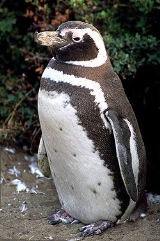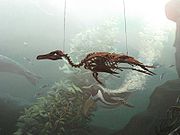
Spheniscus
Encyclopedia
The banded penguins are the penguins of the Spheniscus ("wedge-shaped") genus. There are four living species of penguin
s known as banded penguins, and all have similar coloration. They are sometimes also known as "Jack-ass penguins" due to their loud locator calls sounding similar to a donkey braying. Common traits include a band of black that runs around their bodies bordering their black dorsal coloring, black beaks with a small vertical white band, distinct spots on their bellies, and a small patch of unfeathered or thinly feathered skin around their eyes that can be either white or pink. All members of this genus lay their eggs and raise their young in burrows.
and the southern coasts of Chile
and Argentina
while the Galápagos Penguin is native to the Galapagos Islands
, making it the most northerly of all penguin species. The banded penguins are not (and apparently never were) Antarctic.
 Several extinct species are known from prehistoric fossils:
Several extinct species are known from prehistoric fossils:
The former Spheniscus predemersus is now placed in a monotypic
genus Inguza.
Penguin
Penguins are a group of aquatic, flightless birds living almost exclusively in the southern hemisphere, especially in Antarctica. Highly adapted for life in the water, penguins have countershaded dark and white plumage, and their wings have become flippers...
s known as banded penguins, and all have similar coloration. They are sometimes also known as "Jack-ass penguins" due to their loud locator calls sounding similar to a donkey braying. Common traits include a band of black that runs around their bodies bordering their black dorsal coloring, black beaks with a small vertical white band, distinct spots on their bellies, and a small patch of unfeathered or thinly feathered skin around their eyes that can be either white or pink. All members of this genus lay their eggs and raise their young in burrows.
Ranges
The African, Humboldt, and Magellanic species all live in more temperate climates such as South AfricaSouth Africa
The Republic of South Africa is a country in southern Africa. Located at the southern tip of Africa, it is divided into nine provinces, with of coastline on the Atlantic and Indian oceans...
and the southern coasts of Chile
Chile
Chile ,officially the Republic of Chile , is a country in South America occupying a long, narrow coastal strip between the Andes mountains to the east and the Pacific Ocean to the west. It borders Peru to the north, Bolivia to the northeast, Argentina to the east, and the Drake Passage in the far...
and Argentina
Argentina
Argentina , officially the Argentine Republic , is the second largest country in South America by land area, after Brazil. It is constituted as a federation of 23 provinces and an autonomous city, Buenos Aires...
while the Galápagos Penguin is native to the Galapagos Islands
Galápagos Islands
The Galápagos Islands are an archipelago of volcanic islands distributed around the equator in the Pacific Ocean, west of continental Ecuador, of which they are a part.The Galápagos Islands and its surrounding waters form an Ecuadorian province, a national park, and a...
, making it the most northerly of all penguin species. The banded penguins are not (and apparently never were) Antarctic.
Extant
The four extant (living) species of banded penguins (Spheniscus) are:| Image | Common name | Binomial name |
|---|---|---|
| Magellanic Penguin Magellanic Penguin The Magellanic Penguin, Spheniscus magellanicus, is a South American penguin, breeding in coastal Argentina, Chile and the Falkland Islands, with some migrating to Brazil where they are occasionally seen as far north as Rio de Janeiro. It is the most numerous of the Spheniscus penguins. Its nearest... |
Spheniscus magellanicus | |
 |
Humboldt Penguin Humboldt Penguin The Humboldt Penguin is a South American penguin, that breeds in coastal Peru and Chile. Its nearest relatives are the African Penguin, the Magellanic Penguin and the Galápagos Penguin... |
Spheniscus humboldti |
_-isabela2.jpg) |
Galápagos Penguin Galapagos Penguin The Galapagos Penguin is a penguin endemic to the Galapagos Islands. It is the only penguin that lives north of the equator in the wild; it can survive due to the cool temperatures resulting from the Humboldt Current and cool waters from great depths brought up by the Cromwell Current... |
Spheniscus mendiculus |
 |
African Penguin African Penguin The African Penguin , also known as the Black-footed Penguin is a species of penguin, confined to southern African waters. It is known as Brilpikkewyn in Afrikaans, Inguza or Unombombiya in Xhosa, Manchot Du Cap in French and Pingüino Del Cabo in Spanish... , Black-footed or Jackass Penguin |
Spheniscus demersus |
Fossil

- Spheniscus muizoni (Pisco Middle/Late Miocene of Cerro La Bruja, Peru)
- Spheniscus chilensis (Late MioceneLate MioceneThe Late Miocene is a sub-epoch of the Miocene Epoch made up of two stages. The Tortonian and Messinian stages comprise the Late Miocene sub-epoch....
/Early PlioceneZancleanThe Zanclean is the lowest stage or earliest age on the geologic time scale of the Pliocene. It spans the time between 5.332 and 3.6 Ma ± 0.005 Ma . It is preceded by the Messinian age of the Miocene epoch, and followed by the Piacenzian age....
of C Andean coast) - Spheniscus megaramphus (Late Miocene/Early Pliocene of C Andean coast)
- Spheniscus urbinai (Late Miocene/Early Pliocene of C Andean coast)
The former Spheniscus predemersus is now placed in a monotypic
Monotypic
In biology, a monotypic taxon is a taxonomic group with only one biological type. The term's usage differs slightly between botany and zoology. The term monotypic has a separate use in conservation biology, monotypic habitat, regarding species habitat conversion eliminating biodiversity and...
genus Inguza.

